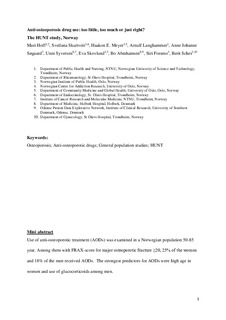| dc.contributor.author | Hoff, Mari | |
| dc.contributor.author | Skurtveit, Svetlana | |
| dc.contributor.author | Meyer, Haakon E | |
| dc.contributor.author | Langhammer, Arnulf | |
| dc.contributor.author | Søgaard, Anne-Johanne | |
| dc.contributor.author | Syversen, Unni | |
| dc.contributor.author | Skovlund, Eva | |
| dc.contributor.author | Abrahamsen, Bo | |
| dc.contributor.author | Forsmo, Siri | |
| dc.contributor.author | Schei, Berit | |
| dc.date.accessioned | 2019-03-20T08:58:07Z | |
| dc.date.available | 2019-03-20T08:58:07Z | |
| dc.date.created | 2018-07-03T10:05:58Z | |
| dc.date.issued | 2018 | |
| dc.identifier.citation | Osteoporosis International. 2018, 29 (8), 1875-1885. | nb_NO |
| dc.identifier.issn | 0937-941X | |
| dc.identifier.uri | http://hdl.handle.net/11250/2590759 | |
| dc.description.abstract | Summary
Use of anti-osteoporotic drugs (AODs) was examined in a Norwegian population 50–85 years. Among them with Fracture Risk Assessment Tool (FRAX) score for major osteoporotic fracture ≥ 20, 25% of the women and 17% of the men received AODs. The strongest predictors for AODs were high age in women and use of glucocorticoids among men.
Introduction
To examine the use of anti-osteoporotic drugs (AODs) and to identify predictors for prescriptions.
Methods
Data were obtained from the Nord-Trøndelag Health Study (HUNT3) performed in 2006–2008 and the Norwegian Prescription Database, including 15,075 women and 13,386 men aged 50–85 years. Bone mineral density (BMD) in the femoral neck was measured in a subgroup of 4538 women and 2322 men. High fracture risk was defined as a FRAX score for major osteoporotic fracture (MOF) ≥ 20%; in the subgroup with BMD, high risk was in addition defined as FRAXMOF ≥ 20% or T-score ≤ − 2.5. Hazard ratios (HRs) for predictors of incident use of AODs within 2 years after HUNT3 were estimated by Cox’ proportional hazards model.
Results
Among individuals with FRAX MOF ≥ 20%, 25% of the women and 17% of the men were treated with AODs. Among those with FRAX MOF < 20%, 3% and 1% were treated, respectively. In the subgroup with BMD measurement, 24% of the women and 16% of the men at high risk of fractures were treated, compared to 3 and 1% in women and men not fulfilling the criteria. In women, high age was the strongest predictor for treatment (HR 3.84: 95% confidence interval 2.81–5.24), followed by use of glucocorticoids (GCs) (2.68:1.84–3.89). In men, predictors were use of GCs (5.28: 2.70–10.35) followed by multimorbidity (3.16:1.31–7.63). In the subgroup with BMD, T-score ≤ − 2.5 was the strongest predictor (women 3.98:2.67–5.89; men 13.31:6.17–28.74).
Conclusions
This study suggests an undertreatment of AODs in individuals at high risk of fracture. | nb_NO |
| dc.language.iso | eng | nb_NO |
| dc.publisher | Springer Verlag | nb_NO |
| dc.title | Anti-osteoporosis drug use: too little, too much, or just right? The HUNT study, Norway | nb_NO |
| dc.type | Journal article | nb_NO |
| dc.type | Peer reviewed | nb_NO |
| dc.description.version | acceptedVersion | nb_NO |
| dc.source.pagenumber | 1875-1885 | nb_NO |
| dc.source.volume | 29 | nb_NO |
| dc.source.journal | Osteoporosis International | nb_NO |
| dc.source.issue | 8 | nb_NO |
| dc.identifier.doi | 10.1007/s00198-018-4560-3 | |
| dc.identifier.cristin | 1595350 | |
| dc.description.localcode | This is a post-peer-review, pre-copyedit version of an article published in [Osteoporosis International] Locked until 17.5.2019 due to copyright restrictions. The final authenticated version is available online at: https://doi.org/10.1007/s00198-018-4560-3 | nb_NO |
| cristin.unitcode | 194,65,20,0 | |
| cristin.unitcode | 194,65,20,15 | |
| cristin.unitcode | 194,65,15,0 | |
| cristin.unitname | Institutt for samfunnsmedisin og sykepleie | |
| cristin.unitname | Helseundersøkelsen i Nord-Trøndelag | |
| cristin.unitname | Institutt for klinisk og molekylær medisin | |
| cristin.ispublished | true | |
| cristin.fulltext | postprint | |
| cristin.qualitycode | 1 | |
